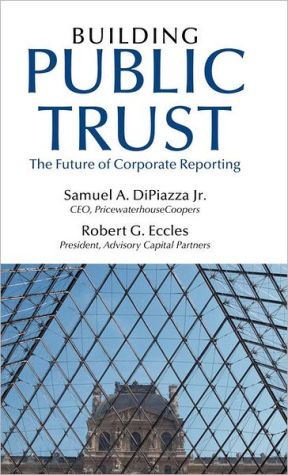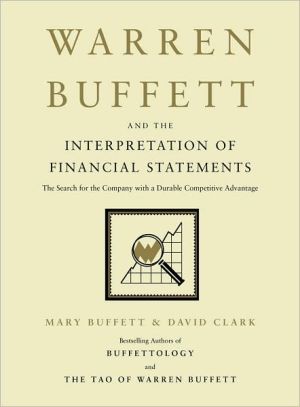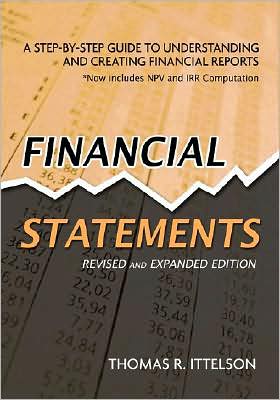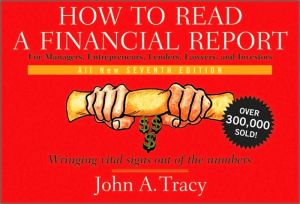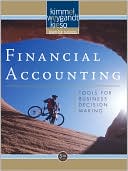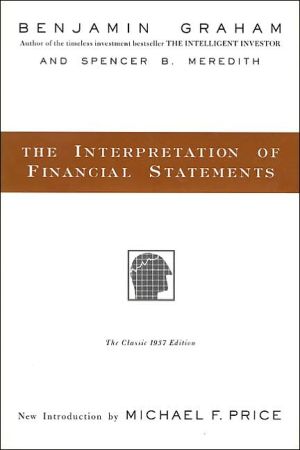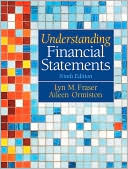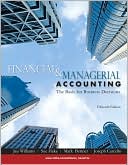Building Public Trust: The Future of Corporate Reporting
From the World's Leading Accounting Firm, A Blueprint for the Future of Corporate Reporting\ "PricewaterhouseCoopers should be commended for its forward thinking on this subject. They have been promoting the benefits of greater corporate transparency long before Enron. We are impressed with their refreshingly candid views on the obligations of corporations, accountants, standard setters, and regulators. Their three-tier model of corporate transparency for building investor confidence in...
Search in google:
There is a crisis in corporate reporting: the Enron bankruptcy; the shattering of a prestigious global accounting firm; criminal and civil litigation against management, financial institutions, and law firms; stock market volatility caused by repeated restatements and uneasy investors–add to this angry U.S. congressional hearings, pressure on and by the Securities and Exchange Commission, and talk of new rules and new regulatory bodies. The impact is global. There are no walls or oceans around this crisis: it affects the entire world’s capital markets, investors, and economies. Why has this happened? What must we do? What insights and innovations will prevent future financial disasters? The worlds of finance and investment need answers. The investing public demands them. In this important new book, written as these events have unfolded, the CEO of PricewaterhouseCoopers and a former Harvard Business School professor put before us their recommendations for addressing the crisis. Take the journey with them, from pioneering concepts to pioneering technology. Their views build on a decade of research, analysis, and dialogue with business leaders assembled by a team of the profession’s finest thinkers. The time is ripe for change. What is needed is an entirely new level of clarity and relevance. To this end, DiPiazza and Eccles propose a Three-Tier model of corporate transparency that draws from the best thinking and practices worldwide. And there is a technology enabler that can help us get there: the authors show that this twenty-first-century style of reporting is a perfect fit for new Internet/XBRL technology. This is the book we were waiting for. The blueprint for the future of corporate reporting is in these pages. Committed to quality, clarity, and relevance in corporate reporting, now and in the future, PricewaterhouseCoopers shares its thinking in a time of crisis and renewal. Building Public Trust: The Future of Corporate Reporting continues and deepens thinking first presented in another book from PricewaterhouseCoopers and John Wiley & Sons: The ValueReporting Revolution: Moving Beyond the Earnings Game, by Robert G. Eccles, Robert H. Herz, E. Mary Keegan, and David M. H. Phillips. About the Authors: Samuel A. DiPiazza Jr. is the CEO of PricewaterhouseCoopers, the global professional services firm with some 150,000 employees, operating in virtually every country worldwide. Mr. DiPiazza has enjoyed a long career with PricewaterhouseCoopers, which he joined in 1973. He most recently served as Senior Partner and Chairman of the U.S. firm with executive responsibility for U.S. operations. Robert G. Eccles is founder and president of Advisory Capital Partners, Inc. (ACP), and a Senior Fellow of PricewaterhouseCoopers. Since 1993, ACP has provided strategic, financial, and organizational advisory services to both large companies and fast-growing small and medium-sized ones. Prior to founding ACP, Dr. Eccles was a full professor at Harvard Business School, where he was a faculty member for fourteen years, receiving tenure in 1989. Soundview Executive Book Summaries The trust of the general public in the capital markets - which is recognized as the foundation of value creation all over the world - has been shaken. The straw that broke the camel's back was the Enron scandal - a fiasco that forced the largest market cap company to declare bankruptcy. The authors of Building Public Trust write that the signs of serious flaws in the capital markets were already present - from well-publicized business failures to the collapse of the Internet bubble to the decline and volatility of the equity markets.Enron and other scandals have focused the public's attention on the institutions and people responsible for the information on which investors (as well as lenders, trading partners, customers and employees) depend. Samuel DiPiazza, the CEO of PricewaterhouseCoopers, and Robert Eccles, a former professor at Harvard Business School and president of Advisory Capital Partners, write that public trust must be restored in this information - and in the purveyors of that information. Building Public Trust offers a model of corporate reporting that works to restore that public trust and confidence. The authors write that the goal of this model is to ensure a spirit of transparency, a culture of accountability and the participation of people of integrity in the corporate reporting process. The Corporate Reporting Supply Chain The authors explain that the Corporate Reporting Supply Chain is responsible for supplying the information on which investors (as well as lenders, trading partners, customers and employees) depend to make their financial decisions. The Corporate Reporting Supply Chain begins with the company executives who prepare the financial statements that are reported to investors and stakeholders. These financial statements are approved by a board of directors, attested to by an independent auditing firm, analyzed by sell-side analysts and broadcast by information distributors, including data vendors and the news media. The entire chain is supported by standard setters, market regulators and enabling technologies. The authors write that the time has come to reexamine how the Corporate Reporting Supply Chain works and offer ways it can be improved. They write that trust in the capital markets depends on faith in the Corporate Reporting Supply Chain - and that faith has been broken. To restore that faith, the authors write that corporate reporting reforms must rebuild the three key elements that create public trust in the markets: a spirit of transparency, a culture of accountability and people of integrity. A Spirit of Transparency The authors write that the first key element of trust is a spirit of transparency. Corporations - that is, the people who work in corporations supported by the corporation's board of directors - have an obligation to provide the information that investors need to make the right investment decisions. Unfortunately, the authors explain, management and boards are not making the information that they know investors need readily available. The second key element of trust that the authors delve into is a culture of accountability. They write that the members of the Corporate Reporting Supply Chain must feel a sense of accountability to the other members of the chain. Management, they explain, must hold itself accountable to shareholders. The authors write that boards must see that this accountability is recognized and maintained. People of Integrity The authors explain that the third key element needed for public trust is people of integrity. Despite rules and regulations, processes and best practices, the authors write that the entire structure of corporate reporting collapses if it is not supported by people of integrity trying to do the right thing. The vision of corporate reporting presented in Building Public Trust is based on a new model of corporate disclosure and a fresh view of the responsibility of each link in the Corporate Reporting Supply Chain. The first tier of this model is global generally accepted accounting principles. The authors explain that companies today use a variety of generally accepted accounting principles (or global GAAP), but most of these principles are country-based. They write that even the best country-based GAAP standards are based on the historical cost model that many consider obsolete or, at best, irrelevant in the complex global environment of today's business. The second tier of the model the authors present is industry-based standards. The standards they discuss are global standards. How industries create value for shareholders and the knowledge that industries need to create that value vary widely from industry to industry. Therefore, the authors explain, country-based accounting standards are less relevant and helpful than international industry-based standards. A fundamental key to the success of tier-two standards, the authors write, is that the standards should be developed by the industry participants themselves and should be voluntary, not regulated. The authors write that companies, as well as accounting firms, analysts and investors, should be involved in the development of these standards. Why Soundview Likes This Book The authors of Building Public Trust are able to offer clear, timely advice to their readers by advocating openness and consistency throughout good and bad economic times. They also introduce a new model of corporate reporting that offers new hope for investors, as well as new technology that aims to support responsible, transparent corporate reporting and renew public confidence and trust. Copyright (c) 2002 Soundview Executive Book Summaries
From Chapter OneInformation is the lifeblood of the capital markets. Investors risk their hard-earned capital in the markets in great measure based on information they receive from their target companies. They need reliable information on a timely basis. They want it in language they can understand, and they should receive it in formats they can easily use for analysis. When the information comes from companies, investors need confidence that it is complete, accurate, and trustworthy. Management, an independent board of directors, and independent auditing firms -- supported by accounting standard setters and market regulators -- have specific yet interrelated responsibilities for ensuring the highest quality information possible. Investors and others have a specific responsibility as well-ensuring high-quality analysis of the information they receive. Investors understand that in free capital markets the opportunity for gain comes with the possibility of loss. But investors have the right to expect that the benefits or consequences will result from the decisions they make, not from flawed information. Similarly, many other stakeholders make important decisions -- for example, whether to work for or do business with a company-using information that companies report. Such stakeholders also need complete, accurate, and trustworthy information and they too must take responsibility for any necessary analysis. Since the equity markets peaked in early 2000, events all over the world have shaken public confidence in the quality of reported information. A number of corporate failures and scandals have undermined the very trust investors place in those responsible for reporting that information. For markets to function efficiently and effectively, the Corporate Reporting Supply Chain -- company executives, boards of directors, information distributors, independent auditing firms, third-party analysts, standard setters, and market regulators -- along with enabling technologies for producing and consuming information must be dependable. The need for more and better information, now heightened by a lack of trust, has led to a much more insistent demand for greater corporate transparency. Investors want greater transparency not only from companies and boards of directors, but also from independent auditors about their relationships with their audit clients. Investors want greater transparency from sell-side analysts about their compensation, potential conflicts, and how they do their work. They want the same clarity from standard setters and market regulators about how they make and enforce rules. With these calls for greater transparency come demands that all of these groups and individuals be held to higher standards of accountability. \ The Corporate Reporting Supply Chain\ Investors are not alone. Lenders, customers, suppliers, employees, and nongovernmental organizations (NGOs) have added their voices to the cry for transparency. The information-based decisions of all of these stakeholders affect investors because they can affect a company's stock price. Executives and boards will serve their enlightened selfinterests by heeding the cry for greater transparency. PricewaterhouseCoopers research has shown that investors, analysts, and executives themselves all believe that better disclosure can have significant benefits for companies: more long-term investors, greater analyst following, improved access to new capital and a lower cost of capital, increased management credibility, greater management accountability, and higher share prices. Higher share prices clearly benefit shareholders when they are based on real value creation -- and not on the management of earnings expectations and reported earnings. When value creation is real, the size and liquidity of the markets are more likely to increase on a sustained basis and result in more wealth not only for shareholders, but also for society as a whole. Movement toward greater transparency\ Many companies in the marketplace have been dedicated for many years to a spirit of transparency and openness. This book offers more than a few examples. For instance, some companies are providing better segment information or working to make financial statements easier to understand. Some companies go beyond regulatory requirements and report nonfinancial information that offers the investor a richer and more accurate company profile. This nonfinancial information includes performance on "value drivers" that are the basis for future financial results-for example, effective customer relationship management, development of human capital, and improvements in the innovation process. Other companies provide forward-looking information to give investors insights into management's view of the future. Still more use the Internet not only to present financial statements, but also to post executives' speeches and to include individual investors in Web-based conference calls. Alongside this electronic channel, members of the management team are making themselves more available for direct discussions with investors and other stakeholders. Boards of directors are beginning to look harder at companies' internal control and risk management systems. Auditing firms continue to improve their methodologies for providing assurance on reported financial statements. Firms that provide sell-side research are taking steps to eliminate any conflicts of interest and to ensure the quality of the research they publish. Standard setters are examining whether existing accounting standards provide the necessary information in a way that is useful to investors. Market regulators are looking harder at the roles played by all of these groups to ensure that each holds itself accountable for properly fulfilling its role.\ A new model for corporate transparency\ Despite the many ongoing efforts to improve how the markets function, each group involved has its own goals and its own rather narrow view of what will make things better. The market requires a larger organizing framework that will focus all of these efforts on the overarching goal of ensuring that investors and other stakeholders get the information they need to make appropriate decisions. The Three-Tier Model of Corporate Transparency is one alternative for a new vision of the future of corporate reporting. Much is being done today to make each of these tiers a reality, and suggestions for how to accelerate this progress are included in this book. The model's three tiers include:\ \ A set of truly global generally accepted accounting principles (Global GAAP).\ Standards for measuring and reporting information that are industry-specific, consistently applied, and developed by the industries themselves.\ Guidelines for company-specific information such as strategy, plans, risk management practices, compensation policies, corporate governance, and performance measures unique to the company.\ \ The Three-Tier Model of Corporate Transparency\ The Three-Tier Model does not ask companies simply to report information in three disconnected tiers. Investors and other stakeholders will benefit fully only if companies communicate the information in each tier in an integrated fashion that provides a holistic view of the enterprise-its marketplace opportunities, its strategies and their implementation, its value drivers, and its financial outcomes. Chapter 5 presents one model for doing this, the Value- ReportingTM Framework. The following paragraphs offer a more thorough discussion of what the three tiers mean, including how the elements in each tier can change. Tier-Three information can move to Tier Two and Tier-Two information can move to Tier One. Beyond these shifts, the opportunity will always exist to add more information at Tier Three.\ Tier one: global generally accepted accounting principles\ Companies today use a wide variety of generally accepted accounting principles (GAAP) for reporting their financial results. Many different forms of country-based GAAP exist, such as those of Australia, Germany, Japan, the United Kingdom, and the United States. The closest the corporate reporting world has come to Global GAAP is the International Financial Reporting Standards (IFRS), formerly named International Accounting Standards, which will be mandatory for all listed companies in the European Union by the year 2005.2 Chapter 2 discusses the key issues that must be addressed in creating Global GAAP, including the important and complicated matter of how to gain acceptance for it in the United States. A compelling argument can be made for Global GAAP as the foundation for the future of corporate reporting. Just as markets for tangible products have become global, so have the capital markets. Companies want access to capital markets all over the world because they want to tap into large pools of liquidity-such as on the exchanges in London (10 percent nondomestic listings), Nasdaq (15 percent nondomestic), or New York (19 percent nondomestic).3 Others wish to use their stock to make acquisitions in foreign countries where the company does business. While more and more companies want access to the world's capital markets, without a global set of generally accepted accounting principles the process of getting there is very difficult and expensive. Market regulators and the stock exchanges they oversee impose a variety of rules regarding the appropriate set of accounting standards companies must use in local markets. They often require a listed company to convert to the host country's GAAP, U.S. GAAP, or to International Financial Reporting Standards. Others require companies to reconcile their local GAAP results to standards acceptable to the host country. For example, non-U.S. companies that want to list in the United States must either convert their results to U.S. GAAP or use other recognized standards reconciled to U.S. GAAP. The lack of Global GAAP results in frictional costs that impair a company's ability to gain access to global pools of capital. Investors also bear their share of the problems. Just as companies want access to capital around the world, investors wish to invest around the world. But the vast differences that exist among national and international accounting standards, and in the levels of transparency they create, impair the ability of investors to compare the financial performance of companies that report according to different sets of standards.\ Differences also exist in how rigorously executives and their boards apply these standards in creating their financial statements, how independent accounting firms audit them, and how market regulators enforce adherence to them. When accounting standards and the rigor with which they have been enforced are suspect, companies pay a very real price. Uncertainty about the reliability of reported financial information can be reflected in a higher cost of capital through a lower share price. Investors will demand a greater return in order to compensate for the higher level of risk caused by greater uncertainty about the quality of the information provided. This has happened to a number of companies in the United States when declines in stock prices have followed closely on the heels of questions about the quality of revenues or earnings. The negative consequences of incomplete and unreliable information can extend well beyond an individual company or even stock market. They can affect an entire economy. In an analysis of the Asian crisis, the International Monetary Fund (IMF) reported that "although private sector expenditure and financing decisions led to the crisis, it was made worse by governance issues, notably government involvement in the private sector and lack of transparency in corporate and fiscal accounting and the provision of financial and economic data."4 If Global GAAP existed, investors could much more easily and accurately compare the performance of any company, in any country, in any industry. This would vastly broaden their investment choices because they could avoid the difficulty and costs of comparing company performance and assessing risk across different types of GAAP. Risks due to a country's economic and political situation, the quality of governance and market regulation, and the company's industry dynamics would still exist, but at least an investor would have reliable and comparable information on any company of interest. At Tier One, market regulators worldwide would agree to allow any company using Global GAAP to list on the exchanges within their jurisdictions. At their discretion, they could decide whether or not to make Global GAAP mandatory for domestic companies or even for all companies that seek access to public or private capital. In some circumstances, a preferable approach might be to let some companies continue using local GAAP-private companies or publicly listed small and medium-sized enterprises. However, those publicly listed companies that did not also produce Global GAAP financial statements would eventually find capital in other parts of the world difficult to access and expensive.\ Tier two: industry-based standards\ An obvious impact of globalization is that companies within any given industry increasingly compete with their counterparts in other countries. Further, the competitive dynamics of specific industries, how those industries create value for shareholders, and the knowledge needed to create value vary widely across different industries. What other stakeholders want to know also varies across industries. For example, environmental and social NGOs want different types of information about oil and gas companies (e.g., environmental impact) as compared to the information they want about apparel manufacturing companies (e.g., labor practices in developing countries). Assume that an investor has decided to invest in a particular industry. The next decision is to choose among companies within that industry, and this naturally requires comparing one company's performance to that of its competitors. Global GAAP provides a foundation for this type of comparative analysis, but a standard set of accounting principles is not enough. Investors need supplemental information, both financial and nonfinancial, to gain a more complete view of a company's past performance and to make inferences about its future prospects. Examples of supplemental financial information include pro forma earnings and free cash flow, neither of which is covered by any form of GAAP. Examples of nonfinancial information include performance measures relating to intellectual capital and environmental pollution. Even for the same measure, the methodology used can vary substantially across industries. Banks, for example, do not measure customer satisfaction in the same way that hospitals do. PricewaterhouseCoopers research in a broad range of industries shows conclusively that what drives value differs dramatically across industries. Chapter 3 offers a brief comparison between the telecommunications and pharmaceutical industries to illustrate such differences. Global investors are not alone in their need to compare a company's performance with others. Executives must compare their companies with peers in other countries to evaluate the competitive landscape. For example, a money center bank in London that competes globally for corporate or retail customers needs to compare its performance to competitors in Frankfurt, New York, and Tokyo. Predominantly, it needs to make relevant comparisons based on information about the value drivers specific to banking. That is where the difficulty begins. Companies within the same industry report industry-specific value driver information in an uneven fashion due to the lack of universally accepted definitions, measurement methodologies, and reporting conventions. Even if many companies in an industry reported on an important piece of nonfinancial information-such as customer retention in banking and insurance or market growth and market share in high technology or telecommunications-the usefulness of this information would be limited if one company's set of numbers could not be compared to those of others. To make such industry-specific information-the domain of Tier Two-truly useful to both investors and companies, standards are needed. Ideally, these standards will be developed by global, industry-based groups such as trade associations in collaboration with others in the Corporate Reporting Supply Chain, including the investor community, analysts, professional services firms, and independent accountants. To create an incentive for this to happen and to prevent liability concerns from inhibiting transparency, regulation and legislation that provide "safe harbor" legal protection to companies reporting according to these standards should apply. Companies that provide useful forward looking information to investors, explicitly identified as such, should not be penalized for doing so. Although certainly not a widespread movement yet, examples can be found of industry-based groups that have proposed what could be considered Tier-Two measurement standards. The Society of Petroleum Engineers and the World Petroleum Congress, for example, have jointly developed a set of principles for petroleum reserves and encourages companies to use them; although the developers say that the principles "should not in any manner be construed to be compulsory or obligatory."5 In the hotel industry, the Uniform System of Accounts for the Lodging Industry, a uniform accounting and financial reporting system for hotels, has noted "revenue per available room (RevPAR)" as an industry-specific measure with suggested methods of calculation.6 Even though Tier-Two standards will be developed at the industry level, the possibility certainly exists that some of them could eventually be incorporated into Tier One. For example, certain financial measures of risk and value might be developed in several industries that would be useful in many others. Independently developed industry standards might be similar enough that they could form the basis for new standards within Global GAAP.
ForewordPrefaceSubject Matter ExpertsAcknowledgmentsPrologue1Ch. 1Three Tiers9Ch. 2Accounting Standards33Ch. 3Industry Standards56Ch. 4Good Management81Ch. 5Corporate Reporting104Ch. 6The Internet129Ch. 7Future Audits153Epilogue175Index181
\ Soundview Executive Book SummariesThe trust of the general public in the capital markets - which is recognized as the foundation of value creation all over the world - has been shaken. The straw that broke the camel's back was the Enron scandal - a fiasco that forced the largest market cap company to declare bankruptcy. The authors of Building Public Trust write that the signs of serious flaws in the capital markets were already present - from well-publicized business failures to the collapse of the Internet bubble to the decline and volatility of the equity markets.\ Enron and other scandals have focused the public's attention on the institutions and people responsible for the information on which investors (as well as lenders, trading partners, customers and employees) depend. Samuel DiPiazza, the CEO of PricewaterhouseCoopers, and Robert Eccles, a former professor at Harvard Business School and president of Advisory Capital Partners, write that public trust must be restored in this information - and in the purveyors of that information.\ Building Public Trust offers a model of corporate reporting that works to restore that public trust and confidence. The authors write that the goal of this model is to ensure a spirit of transparency, a culture of accountability and the participation of people of integrity in the corporate reporting process.\ The Corporate Reporting Supply Chain\ The authors explain that the Corporate Reporting Supply Chain is responsible for supplying the information on which investors (as well as lenders, trading partners, customers and employees) depend to make their financial decisions. The Corporate Reporting Supply Chain begins with the company executives who prepare the financial statements that are reported to investors and stakeholders. These financial statements are approved by a board of directors, attested to by an independent auditing firm, analyzed by sell-side analysts and broadcast by information distributors, including data vendors and the news media. The entire chain is supported by standard setters, market regulators and enabling technologies.\ The authors write that the time has come to reexamine how the Corporate Reporting Supply Chain works and offer ways it can be improved. They write that trust in the capital markets depends on faith in the Corporate Reporting Supply Chain - and that faith has been broken. To restore that faith, the authors write that corporate reporting reforms must rebuild the three key elements that create public trust in the markets: a spirit of transparency, a culture of accountability and people of integrity.\ A Spirit of Transparency\ The authors write that the first key element of trust is a spirit of transparency. Corporations - that is, the people who work in corporations supported by the corporation's board of directors - have an obligation to provide the information that investors need to make the right investment decisions. Unfortunately, the authors explain, management and boards are not making the information that they know investors need readily available.\ The second key element of trust that the authors delve into is a culture of accountability. They write that the members of the Corporate Reporting Supply Chain must feel a sense of accountability to the other members of the chain. Management, they explain, must hold itself accountable to shareholders. The authors write that boards must see that this accountability is recognized and maintained.\ People of Integrity\ The authors explain that the third key element needed for public trust is people of integrity. Despite rules and regulations, processes and best practices, the authors write that the entire structure of corporate reporting collapses if it is not supported by people of integrity trying to do the right thing.\ The vision of corporate reporting presented in Building Public Trust is based on a new model of corporate disclosure and a fresh view of the responsibility of each link in the Corporate Reporting Supply Chain. The first tier of this model is global generally accepted accounting principles. The authors explain that companies today use a variety of generally accepted accounting principles (or global GAAP), but most of these principles are country-based. They write that even the best country-based GAAP standards are based on the historical cost model that many consider obsolete or, at best, irrelevant in the complex global environment of today's business.\ The second tier of the model the authors present is industry-based standards. The standards they discuss are global standards. How industries create value for shareholders and the knowledge that industries need to create that value vary widely from industry to industry. Therefore, the authors explain, country-based accounting standards are less relevant and helpful than international industry-based standards. A fundamental key to the success of tier-two standards, the authors write, is that the standards should be developed by the industry participants themselves and should be voluntary, not regulated. The authors write that companies, as well as accounting firms, analysts and investors, should be involved in the development of these standards.\ Why Soundview Likes This Book\ The authors of Building Public Trust are able to offer clear, timely advice to their readers by advocating openness and consistency throughout good and bad economic times. They also introduce a new model of corporate reporting that offers new hope for investors, as well as new technology that aims to support responsible, transparent corporate reporting and renew public confidence and trust. Copyright (c) 2002 Soundview Executive Book Summaries\ \ \
